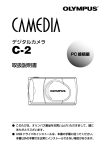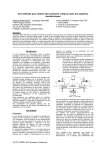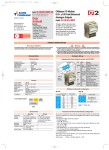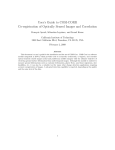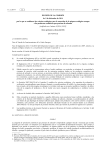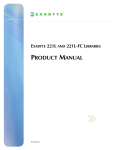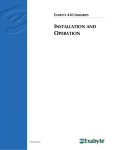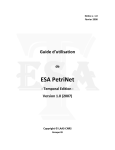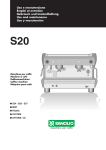Download Critical scenarios derivation methodology for mechatronic systems
Transcript
Reliability Engineering and System Safety 84 (2004) 33–44 www.elsevier.com/locate/ress Critical scenarios derivation methodology for mechatronic systems Hamid Demmoua,*, Sarhane Khalfaouia,b, Edwige Guilhemb, Robert Valettea a Laboratoire d’Analyse et d’architecture des Systèmes LAAS CNRS, 7 avenue du Colonel Roche, F-31077 Toulouse cedex, France PSA Peugeot Citroën, Direction des Systèmes d’Information, 18 rue des Fauvelles, F-92256 La Garenne Colombes cedex, France b Abstract This paper deals with safety in design of mechatronic systems. We propose a method based on a qualitative analysis of a Petri net model of the system. It allows deriving feared scenarios by determining the sequences of actions and state changes leading to the feared state in which the passenger’s safety is no longer guaranteed. The Petri net model of the system takes into account normal behaviour, failures and reconfiguration mechanisms. Our approach uses linear logic as formal framework and is based on a backward and a forward reasoning. It derives feared scenarios as causal relationships between normal states and the feared one. q 2003 Elsevier Ltd. All rights reserved. Keywords: Reliability in design; Feared scenarios; Mechatronic systems; Petri net; Linear logic; Hybrid systems 1. Introduction New cars include more and more electronic and computing systems that enhance the engine performance, active security and reduce petrol consumption and air pollution. Nevertheless, this enhancement makes more complex the safety analysis of such embedded systems composed of mechanic, hydraulic, electronic and computing parts, and called mechatronic systems. Classical methods of safety, as fault trees, are not sufficient to deal with this kind of complex and hybrid systems because they are static [11]. The qualitative analysis of Petri net [1,2] models of mechatronic systems aims at identifying the actions that leads to situations, where the safety of passengers is no more guaranteed. The search of the feared scenarios (by exploring the reachability graph) contributes to the evaluation of safety and the choice of the system architecture at the design stage. Nevertheless, when generating the reachability graph, we come up against the combinatorial explosion of the number of states [3]. * Corresponding author. Tel.: þ33-5-61-33-69-16; fax: þ 33-5-61-3369-36. E-mail addresses: [email protected] (H. Demmou); sarhane.khalfaoui@ mpsa.com (S. Khalfaoui); [email protected] (E. Guilhem); [email protected] (R. Valette). 0951-8320/$ - see front matter q 2003 Elsevier Ltd. All rights reserved. doi:10.1016/j.ress.2003.11.007 One way to avoid this combinatorial explosion is to use directly the Petri net model to extract the feared scenarios without generating the reachability graph. To do so, it is helpful to use linear logic [4] to get a new representation (based on causality point of view) of the Petri net model, and then extract the scenarios from this new representation. The advantage is that with linear logic we can express partial order of transition firings and focus the search on the parts of the model that are interesting for safety analysis. This approach is based on the equivalence of reachability in the Petri net and provability of a sequent1 in linear logic. The fact that feared scenarios are rare makes the simulation-based methods ineffective [3]. In order to help designers to deal with safety constraints, the feared scenarios must be obtained directly from a model of the system. A qualitative and quantitative analysis is necessary to choose the safest architecture. The hybrid aspect of mechatronic systems (both continuous and discrete features) leads us to choose a model that associates Petri nets and differential equations [5]. The Petri net model describes the operation modes, the failures and the reconfiguration mechanisms. The differential equations represent the evolution of continuous variables of the energetic part of the system. 1 A sequent is a logic expression of the form: G; X r Y; D which means: G and X permit to deduce Y or D: G; X; Y; and D are logical formulas. 34 H. Demmou et al. / Reliability Engineering and System Safety 84 (2004) 33–44 This paper presents an approach for the analysis of the safety of mechatronic systems. It aims to characterise the feared scenarios at the early design stage of the system. We propose a method based on a qualitative analysis of the Petri net model, from which we can deduce the feared scenarios, and identify the sequences of actions leading to the feared state. The formal framework of our approach is linear logic. In Section 2, we present how linear logic is used to analyse a Petri net model in order to extract feared scenarios. In Section 3, we apply the critical scenarios derivation method on a simple mechatronic system. The results will be compared to those given by the classical Fault Tree method. 2. Petri nets and linear logic 2.1. Principles of linear logic Linear logic proposed by Girard [4] is a restriction of the classical prepositional logic in order to introduce the notion of resource. The logical propositions are not considered as eternal truth but are as resources that can be produced and consumed. A deduction in linear logic consumes the propositions, which form the premises, and produces the propositions that form the conclusion. In order to deal with the concept of resources, Girard introduced new logical connectors. The set of these connectors is divided in three groups: multiplicative, additive and exponential connectors. In our approach we only use a part of the MILL (Multiplicative Intuitionnistic Linear Logic) fragment. For sake of simplicity we present only the TIMES (^) and linear implication (w) connectors, which the most used ones in our approach. The TIMES (^) connector is the multiplicative conjunction. It traduces the accumulation of resources. The proposition A^A means that two resources A are available. The Linear implication (w) expresses the causality between production and consumption of resources. The proposition AwB means that when we consume the proposition A we produce the proposition B: 2.1.1. Sequent calculus and proof tree A sequent is a formula of the form G; G0 r D; D0 ; where the symbol ( r ) means that the conjunctions of G and G0 allows to deduce the disjunction D or D0 . According to the sequent calculus, proving a sequent is to construct a proof tree; starting from the sequent and applying step by step some adapted rule the proof consist on eliminating the connectors. An example of sequent proving is given in Fig. 1. In our approach we used only rules of the MILL fragment. These rules belong to three groups as shown in Fig. 2. Fig. 1. Proof tree of sequent A; AwB r A: 2.2. Logical reasoning on Petri nets One way to deal with reachability in Petri nets is to resolve the characteristic equation: M 0 ¼ M þ Cs: This equation gives only the necessary condition (not sufficient) of the reachability between two markings M and M 0 ; but doesn’t give the firing order of transitions of sequence s: Based on the sequent calculus, linear logic helps to get a necessary and sufficient condition of reachability from one marking to another, thanks to the equivalence between the reachability in the Petri net and the provability of the corresponding sequent [6]. Moreover linear logic gives the partial firing order of the different transitions to reach a final marking M 0 from an initial one M: Translation of a Petri net to linear logic was presented in Ref. [6]. A logical formula is associated with each marking and each transition. The left hand of the initial formula (sequent) must hold the list of all the transitions that must be fired to obtain a marking M 0 from an initial marking M: The building of the proof generates a proof tree beginning by a sequent and finishing by the identity axiom. Moreover, it is possible to extract information about the firing order of transitions from the proof tree of the sequent [7], and temporal evaluation of scenarios in temporal Petri nets. In this way, linear logic is considered as an analysis tool for Petri nets. Some fundamental rules have to be used such as the left introduction rule of the linear implication. 2.2.1. Left introduction rule of the linear implication This rule, noted wL; is part of the fragment MILL rules presented in Fig. 2. It acts on the left member of a sequent ðG; G0 ; FwG r HÞ and generates two fragments G r F and Fig. 2. Sequent calculus rules of the MILL fragment. H. Demmou et al. / Reliability Engineering and System Safety 84 (2004) 33–44 G0 ; G r H as it is shown on the following formula: G r F G0 ; G r H wL: G; G0 ; FwG r HÞ When analysing a Petri net with linear logic, the use of this rule corresponds to the firing of a transition. The other rules of the logical group acts in the same way as the left implication rule. 2.2.2. Forward reasoning In this approach, transitions of the Petri net are translated to linear logic propositions. When building the proof tree, the consumption of one proposition will represent the effective firing of the corresponding transition. For a given Petri net, the translation is done as follows: 1. An atomic proposition P is associated with each place p of the Petri net. 2. A monome using the multiplicative conjunction ^ (TIMES), is associated with each marking, pre-condition Pre( ) and post-condition Post( ) of transition. 3. To each transition t of the net an implicative formula is defined as follows. t: ^ i[Preðpi ;tÞ Pi w ^ o[Postðpo ;tÞ Po Each sequent of the form M; t1 ; …; tp r M 0 expresses the reachability between the marking M and M 0 ; by indicating which are the fired transitions ðt1 ; …; tp Þ: The proof is derived in a canonical way [4]. Using the rule for introducing the (^) connector on the left hand side ð^LÞ allows changing the initial marking with a set of atomic formulas (tokens, not necessarily used at the same date). By applying the ðwLÞ rule, it is now possible to extract the causal relations of the atomic formulas from marking M to M 0 : To describe this method we applied it on the following Petri net with one token in place A and one token in place E : The forward reasoning is derived on the canonical form as shown in the following proof tree 2.2.3. Backward reasoning In this approach, it is possible to do a backward reasoning from the final marking to the initial one. The reasoning is done on resources that can be produced, and we are interested in the date of their production. In the forward reasoning the resources are consumable and we are interested in the date of their consumption. In linear logic 35 it leads to exchange the ^ (TIMES) connector by the ‘ (PAR) connector. For sake of simplicity, we choose to only use the (^) connector. This is possible if we apply the forward reasoning on the reversed Petri net (the initial Petri net in which all arcs are reversed). So, backward reasoning will be considered as a forward reasoning carried out on the reversed Petri net. Another advantage of this choice is to allow the application of the same algorithm to both forward and backward reasoning. 2.2.4. Reasoning in an unknown context We want to find a sequence of actions (transition firings), and the associated context (necessary tokens) that leads to a token in the place representing the partial feared state. We don’t know the initial marking, and about the final marking we only know a part that contains the partial feared state. We don’t know which transitions have to be fired. The problem is to write the right sequent that will initiate the desired search. It is necessary to write the list of the transitions that have to be considered, without knowing how many times exactly they will be fired. To express this kind of constraints in linear logic we use the exponential connector ‘!’. When we write !t in a sequent, it means that transition t can be fired zero, one or k times, depending on the needs and the progress of the proof. If Md represents the partial feared state, the sequent that initiates the backward reasoning will be: Md ; G1; !t1 ; …; !tn r G2; where G is a context that must be produced simultaneously with Md ; and t1 ; …; tn represent all the transitions of the Petri net. The formula Mn ; G; !t1 ; …; !tn r M 0 can be used in the same way for the forward reasoning. 2.3. Deriving critical scenarios: a general method The aim of a qualitative analysis is to point out the sequence of actions that leads to the feared states and to analyse more precisely what makes the system leave the normal behaviour and reach the feared state. Our method starts by a backward reasoning from the feared state in order to identify the causal chain of actions leading to that feared state. The backward reasoning is stopped when a nominal sate is reached. A forward reasoning follows it in order to obtain all the possible evolutions from this partial nominal state. The bifurcation between the nominal behaviour and the feared one is identified and corresponds to a transition conflict in the Petri net. 2.3.1. Sample example The proposed approach is now illustrated in the following example of Fig. 3. Place D represents the feared state, place N a normal behaviour state, place A a non-faulty actuator, and place AF a faulty actuator. Transition t1 corresponds to a normal 36 H. Demmou et al. / Reliability Engineering and System Safety 84 (2004) 33–44 Fig. 3. Sample example. Fig. 5. Example. behaviour. We are searching for all the scenarios (set of transition firings) that lead to the marking of place D: By applying our method it is possible to find out, in a logical framework, the causal link between the marking of D and that of AF. the process of building the proof and put G2 ; 1 (1 is the neutral element of the ^). Let’s put M ; N^A: We obtain the following cycle N; A; !t1 r N^A: During the proof building, we applied twice the wL rule. This corresponds to a firing of transition t2 ; followed by an undefined number of firing of t1 in the reversed Petri net of Fig. 5. The final sequent resuming all the steps is: D^A; !t1 ; t2 r N^A: 2.3.1.1. Backward reasoning. At this stage, we use the reversed Petri net (on Fig. 4) in which all the arcs are reversed. The transitions of this Petri net are expressed as follows: t1 : A^NwA^N; t2 : DwN; t3 : AFwA: The initial sequent expressing the reachability of the marking of D is: D; G1; !t1 ; !t2 ; !t3 r M ð1Þ Only transition t2 consumes a token in place D; so the sequent can be rewritten D; G1; t2 ; !t1 ; !t2 ; !t3 r M ð2Þ t1 : A^NwA^N; t2 : NwD; t3 : AwAF: Then we apply the wL rule to the sequent (2): N; G1; !t1 ; !t2 ; !t3 r M D r D wL D; G1; t2 ; !t1 ; !t2 ; !t3 r M We obtain a first sequent that expresses the reachability of the marking of place N : N; G1; !t1 ; !t2 ; !t3 r M 2.3.1.2. Forward reasoning. Thanks to the backward reasoning we have identified a scenario leading to the marking of place D: It represents the reachability of this marking from the marking N^A; after an undefined number of firings of t1 ; followed by one firing of t2 : We are now going to verify if, starting from the marking N^A; we obtain a marking different from D^A; with an indeterminate order of the transition firings. The transitions of the Petri are now expressed as follows: ð3Þ It can be noticed that only transition t1 consumes a token in place N; but in the same time, it produces a token in place A: Let’s put G1 ; A^G2 : It corresponds to the enrichment of the context of the marking, assuming that place A has a token that will be used at the same time than the one in place N: We apply again the wL rule to the sequent (3), using the expression of G1 : N; A; G2; !t1 ; !t2 ; !t3 r M N^A r N; A wL N; A; G2; t1 ; !t1 ; !t2 ; !t3 r M We can see that the initial sequent, N; A; G2; !t1 ; !t2 ; !t3 r M of the proof tree, and the sequent obtained after the application of the wL rule, are the same. We stop The initial sequent is: N^A^G3 ; !t1 ; !t2 ; !t3 r G4 ; with G3 and G4 representing a priori unknown marking context. We can see that the transitions t1 and t2 are in conflict, and also t1 and t3 ; but not t2 and t3 : As a consequence we determine two different proof trees: The one corresponding to the firing of t1 (tree 1). The one representing the firing of the sequence {t2 ; t3 } (tree 2). 2.3.1.2.1. Proof Tree 1. Firing the transition t1 gives: N; A r N^A N; A; G3 ; !t1 ; !t2 ; !t3 r G4 wL: N; A; G3 ; t1 ; !t1 ; !t2 ; !t3 r G4 We obtain the same sequent. So we put G3 ; 1 and G4 ; N^A (so that N; A r G4 is provable). The obtained scenario is: N^A; !t1 r N^A: It corresponds to a linear invariant of transitions. 2.3.1.2.2. Proof Tree 2. The transitions t2 and t3 are parallel, so their firing order is not significant. Let’s choose to fire t2 first and write the corresponding proof: N r N D; A; G5 ; !t1 ; !t2 ; !t3 r G6 wL: N; A; G5 ; t2 ; !t1 ; !t2 ; !t3 r G6 Now, we can fire t3 and write: Fig. 4. Reversed Petri net. A r A D; AF; G5 ; !t1 ; !t2 ; !t3 r G6 wL: D; A; G5 ; t3 ; !t1 ; !t2 ; !t3 r G6 H. Demmou et al. / Reliability Engineering and System Safety 84 (2004) 33–44 We stop the proof because there is no more fireable transitions. We put G5 ; 1 and G6 ; D^AF: Finally we obtain the following sequent: N^A; t2 ; t3 r D^AF: From this sequent we can see that the scenario leading to the marking of D; produces simultaneously the marking of the place AF. 2.3.1.3. Discussion. Our objective is to identify all the scenarios leading to markings containing place D: We started from a sequent expressing the reachability of the marking of D; from an unknown initial marking. By applying a backward reasoning on this sequent and then a forward reasoning, we obtain the final sequent N^A; !t1 ; t2 ; t3 r D^AF that contains all the possible scenarios leading to the marking of place D: From the proof tree we deduce two results: 37 to guarantee the coherence of the method. Deriving scenarios directly from a Petri using linear logic is different from animating a Petri net with a token player. The main difference is that with our approach using linear logic we focus the analysis on partial orders of firings that participate to the derived scenario. In other words we avoid all the interleaving of parallel transitions to the ones that are concerned by the feared scenario. The figure below illustrates the difference between our algorithm based on the use of linear logic and a classic token player. With the token player animating the Petri net on the right it produces sequences like ðt3 ; t1 ; t4 ; t2 ; t3 ; …Þ: Our algorithm will produce two sequences ðt3 ; t4 Þ and ðt1 ; t2 Þ highlighting the causality between t1 and t2 : If the firing of t1 is the normal behaviour, then the state with the marking of D is irreversible (if t2 or t3 is fired, it is no more possible to fire t1 ). The obtained final sequent associating the marking of D and AF, gives more information about the conditions of the occurrence of the feared state, than the one that leads to the marking of D only. 2.4. Contribution of linear logic 3. Critical scenarios and dynamic reliability The key point of our method is the reachability of a partial marking (corresponding to a feared state). Analysing the reachability is a straightforward method to derive critical scenarios. The reachability between two markings in Petri nets can be analysed n two different ways. The first one is based on the fundamental equation M 0 ¼ M þ Cs as discussed in Section 2.2. The resolving of this equation helps to determine a necessary but not sufficient condition of reachability. The second one is based on the reachability graph that we can explore to determine a total ordering of transitions firing to reach a given marking. Unfortunately it is not possible to extract the causality links between the different firings, which is fundamental in scenario deriving. The other limitation of the reachability graph approach is combinatorial explosion that is more important with hybrid systems. So, what is the contribution of linear logic? First with linear logic we transpose the problem of reachability into a problem of sequent proving which is more simple and efficient, and gives a formal and logical framework that assure the coherence of the causality links and the partial orders. Moreover, it is possible to extract from the proof tree crucial information on the partial order of firing of the concerned transition and also temporal evaluations of the scenario. In second we can derive scenarios directly from the Petri net without constructing the reachability graph avoiding the combinatorial explosion. In doing this, linear logic helps us Dynamic reliability refers to systems that evolve dynamically and are such that failures, repairs, controls or operators actions can influence the dynamic and reciprocally. This type of systems can switch from one dynamic to another. Our method is based on a Petri net modelling, linear logic and differential equations (for continuous behaviour). It aims at characterising the causalities between transition firings, and then identifying the potential feared scenarios. This step is based on an analysis of the Petri net model with linear logic. Finally we determine the real feared scenarios by eliminating inconsistent potential ones. These inconsistent scenarios don’t satisfy continuous constraints (which will be represented by thresholds linked to transitions). 3.1. Case study 3.1.1. Presentation The case study is based on a volume regulation system of two tanks (Fig. 6). It is made of a computer, two pumps, three electrovalves, two volume sensors, the two regulated tanks (tanks 1 and 2) and a third tank for draining. The two regulated tanks are used on demand of a user. This demand is described by a function of time flow rates flow rates ds1ðtÞ and ds2ðtÞ: The volume of each tank ðiÞ must be kept inside a given interval ½Vimin ; Vimax : The volume is controlled by the computer, which decides, according to the values given by 38 H. Demmou et al. / Reliability Engineering and System Safety 84 (2004) 33–44 Fig. 7. Model of nominal behaviour of tank 1. Fig. 6. Case study. the volume sensors, to full (or not) the concerned tank by opening (or not) the concerned electrovalve. The control law of the computer is such that the electrovalve is closed when the volume of the controlled tank over crosses the high limit Vimax : In the other hand, the computer commands the opening of the electrovalve each time the value of the volume in the controlled tank is lower than the limit Vimin : We distinguish two normal phases of the system, corresponding to the state of the electrovalve: † A conjunction phase when the electrovalve is open. The volume in the tank is going up, no matter what is the value of the outgoing flowrate to the user (the pump flowrate is much higher than the outgoing flowrate). † A disjunction phase when the electrovalve is closed. The volume in the tank is decreasing. This system supplies the user and must ovoid the overflow of the tanks. A relief electrovalve is added to the system in order to drain the tanks in case of overflow. This third electrovalve is viewed as a shared resource between the two main tanks, and it can be used to drain an only one tank at a time. When the volume of one tank over crosses the high security limit ðViL Þ; the computer commands the opening of the relief electrovalve until the volume becomes lower than Vimin : As we focus our study on critical scenarios, and in order to simplify the problem we consider that only the electrovalves can have failures. A typical failure of the electrovalves 1 and 2 corresponds to a blocked open state (stuck closed) in which the electrovalve does not react to a closure command of the computer. These two electrovalves can be repaired after a failure occurrence. When the electrovalve 3 has a failure it is considered to be definitely out of service. have the Sam failures. When the model of tank 1 and its control law is set up, it is simply duplicated for tank 2, obtaining a model, where only thresholds for the control law and parameters of failures and repairing are different. Fig. 7 shows the model of nominal behaviour of tank 1. The place V1_dec represents the disjunction phase (the volume is decreasing), when place V1_cr represents the conjunction phase in which the volume is increasing. The place EV1_OK corresponds to a state, where the electrovalve 1 works well. The transitions t11 represent the closing command of the electrovalve 1 when the volume over crosses V1max; while the transition t12 represents the opening command of the same electrovalve when the volume becomes lower than V1min: 3.1.2.2. Failure and repairing model of the electrovalve 1. This mode is described in Fig. 8 It represents the fact that the electrovalve can stay blocked in an open state after the firing of transition def1, and that it can be repaired when transition rep1 is fired. 3.1.2.3. Model for the use of the relief electrovalve. This electrovalve can be used in the same way by the two tanks 1 and 2. The sum of EV3 flowrate ant outgoing flowrate is higher than EV1 (or EV2) flowrate (Fig. 9). When the volume in the tank 1 over crosses the high security limit ðV1L Þ; and the relief electrovalve is available (place EV3_OK is marked) then t14 becomes fireable and the draining process of tank 1 can start via the relief electrovalve by marking place EV3_oc1. The relief electrovalve is no longer available for use to drain another tank (tank 2 in the case study); this corresponds to the place EV3_OK empty. This phase last the time that it takes for the volume to reach the low threshold V1min. Then, the electrovalve 3 is released (place EV3_OK is newly marked), and a conjunction phase is started again (place V1_cr is marked) by firing transition t15 : 3.1.2. Modelling 3.1.2.1. Model of nominal behaviour. The nominal behaviour of the system corresponds to a succession of conjunction and disjunction phases, consequently to a series of opening and closing commands from the computer. The two tanks follow the same process and have identical successive states, because the same control law is applied to the tanks, and the two electrovalves Fig. 8. Failure and repairing of electrovalve 1. H. Demmou et al. / Reliability Engineering and System Safety 84 (2004) 33–44 Fig. 9. Use of the relief electrovalve. The electrovalve 3 can have a failure (modelled by transition def3) stuck closed. In that case, place EV3_HS is marked and the electrovalve are set out of order. 3.1.2.4. Model of the complete system. The Petri net of Fig. 10 gives the model of the regulation system. This Petri net integrates the model of nominal behaviour of the two tanks (tanks 1 and 2), the failure and repairing model of the same two tanks, the model for the use of the relief electrovalve, and finally the models of occurrence of the feared events (overflow of tank 1 or tank 2). We say there is overflow on one of the tanks, for instance tank 1, when the volume in this tank over crosses V1S (V1S is higher than V1max and V1L ). In that case, transition t13 is fired and place E_red1 is marked. 3.2. Method for deriving critical scenarios 3.2.1. Basics of the method As stated in Section 2, the goal of this method is to point out the sequence of actions and states that leads to the feared state and to analyse more precisely what makes the system leave the normal behaviour and goes to the feared state. The proposed method is based on a qualitative analysis initiated from the Petri net model. As seen before, this model describes the nominal behaviour and also the behaviour in case of failure. This qualitative analysis is based on causality research between 39 two partial markings (a feared and a nominal one) using linear logic. The matter is to derive and to clearly identify the feared scenarios starting from a model that contains the necessary knowledge to make the analysis. The main problem encountered when analysing critical scenarios by exploring the occurrence graph is the combinatorial explosion of this graph, added to the fact that feared events are rare. In order to avoid the exploration of all the normal states and to focus on the feared states we introduce the concept of context enrichment. The principle of this concept is to progressively enrich the context of occurrence of the event that leads to the feared state. This enrichment is done by adding tokens to some places that can have an impact on the critical scenario that is being explored and by analysing the conflicts that have a causal link with the occurrence of the feared event. Starting from a partial knowledge of the conditions of the feared event occurrence (for instance an alarm signal), we focus on the behaviour that avoids critical one and that in fact corresponds to bifurcations represented by conflicts between transitions. When analysing the necessary conditions to fire these bifurcation transitions we get a more complete and precise information about the occurrence of the feared event. In order to avoid this occurrence (hence to make a bifurcation from the critical path), some conditions are necessary, like for example, the availability of a reconfiguration resource, or the fact that the system is in a defined working state. If these conditions are not satisfied there is no way to avoid the critical scenario and the system will finally reach the feared state. We have enriched our knowledge about the feared event by introducing some conditions not directly related to it (the availability of reconfiguration resource, for example). The study of the behaviours that are in conflict with those which are in conflict with the critical ones (and consequently promote the occurrence of the feared event) give us more precise information about the context of the feared event. This is why our method follows the same basics analysing Fig. 10. Petri net model of the case study. 40 H. Demmou et al. / Reliability Engineering and System Safety 84 (2004) 33–44 step by step each partial state that has an impact on the feared scenario. We have developed a method based on four steps the goal of which aims at determining systematically and formally the conditions for the marking and the unmarking of some given set of places (called target state). The four steps of the method are the following: 1. Determining the normal states (qualitatively and quantitatively). 2. Determining the target states (partial feared states or states to be analysed). 3. Backward reasoning starting from the target state. 4. Forward reasoning starting from the conditioning states (pointing out the bifurcations between normal working and feared scenarios). The first step determines the places that when marked represent a normal working state. They will be called ‘nominal’ places and will be used as stop criteria for the backward reasoning. This step can be achieved in two ways: by using an a priori knowledge of the well working states of the system, or by a Monte Carlo simulation of the model (in a short temporal window) in order to determine the marking probabilities of the places of the Petri net. The places that will have a non-negligible marking probability will be considered as nominal places. The second step determines the target state to be analysed. This target state can be either a partial feared state or another partial state with a direct or indirect link to the feared state (for example a place that represents the availability of a resource that allows a working with presence of a fault, and avoid the occurrence of the feared event). The third step generates the sets of paths that lead to the partial feared state. It consists on reasoning on the reversed Petri net model. That is what we call backward reasoning. Considering this reversed Petri net, the initial marking is set to the feared state and we search for all the minimal scenarios [3] (only the necessary transitions are fired) that lead, from the initial marking to a final marking containing only places that are associated to the nominal working and called nominal places. During this step, in most cases we have to enrich the initial marking (it consists on adding tokens on some empty places). This have to be made each time it is necessary to fire a nonfireable transition (from the initial marking) in order to consume a token in a place not associated to a nominal working. The added tokens when enriching the marking corresponds to partial markings that are logical consequences of feared scenarios. This partial marking are necessarily observed when the system evolves to the feared state. Reversing the scenarios obtained in this step, we get the sequences of actions that lead from a normal state to the feared one. This normal state is called ‘conditioning state’. The last step of the method consists on carrying out reasoning on the initial Petri net model and starting from each conditioning state found in the previous step. This is called forward reasoning. The objective here is to determine all the bifurcations between the feared behaviour and the nominal one, and also the conditions (marking of some places) of these bifurcations. This method uses linear logic for both backward and forward reasoning as described in Section 2. For sake of simplicity, we don’t give the details of the application of linear logic rules and just explain the results in terms of transition firings in the Petri net. In order to better understand this method of scenario derivation, we applied it on the tank regulation case study presented previously. 3.2.2. Application The algorithm is composed of successive iterations each one made of the four previously described steps. The algorithm makes as iterations as necessary to identify all the components interactions that are involved in the feared scenarios. 3.2.2.1. First iteration. 1. Nominal states: They are the striped places in the model of the complete system. 2. Target state: We are interested in the overflow of tank 1. So the target state will be the partial feared state corresponding to the marking of place E_red1. 3. Backward reasoning from the target state: This step gives the list of scenarios leading to the feared state. The only place following place E_red1 is transition t13 : A token is then produced on place V1_cr. This place corresponds to a nominal state, so the backward reasoning is stopped. The obtained scenario represents the reachability of the partial feared state E_red1 from the marking of place V1_cr (the conditioning state), by firing once transition t13 : 4. Forward reasoning from place V1_cr: The goal of this step is to point out the bifurcations between the nominal behaviour and the feared scenarios. The place V1_cr represents a conditioning state from which the system can either evolve to the feared state E_red1, or some other working state. This is indicated by the conflict between the tree transitions t13 ; t11 and t14 that follow place V1_cr. This step gives three possible behaviours, each one corresponding to the firing of t11 ; t13 or t14 : † The feared scenario previously found (firing of t13 from the marking of V1_cr, and obtaining the marking of E_red1). † The firing of t11 from the initial marking (a token in place V1_cr and EV1_OK) leading to the marking of V1_dec and EV1_OK. This scenario represents the closing of electrovalve EV1, when it is not blocked open H. Demmou et al. / Reliability Engineering and System Safety 84 (2004) 33–44 and the volume in tank 1 exceeds the high control limit ðV . V1max Þ: † The firing of transition t14 from the marking of V1_cr and EV3_OK. This firing lead to the marking of place EV3_oc1. This scenario corresponds to the start of the draining of tank 1 with the use of the relief electrovalve EV3 (when EV3 is available). After the application of the method to the partial feared state E_red1 (corresponding to the overflow of tank 1), we obtain the following results: † The occurrence of the feared event (firing of t13 and/or marking of E_red1) is due to the fact that transitions t11 and t14 ; in conflict with t13 ; are not fired. † It becomes necessary to analyse the firing conditions of transitions t11 and t14 : These conditions are the marking of V1_cr and EV1_OK for t11 ; and V1_cr and EV3_OK for t14 : So the analysis is to show how EV1_OK and/or EV3_OK are marked. When analysing the conflicts of t13 with t11 or t14 ; we consider thresholds values of continuous variables, associated to the transitions. For example, t13 is fireable if V1_cr and EV1_OK are marked, and if the condition ðV1 $ V1max Þ is verified. In order to analyse these conflicts we will apply a new iteration of the scenario search method and determine the exact conditions of the firing of t11 and t14 : 3.2.2.2. Second iteration. Let us begin by the firing conditions of transition t11 : To this transition is associated the threshold V1 $ V1max : This condition is always true when t13 is fireable, since that the threshold of t13 is V1 $ V1max and that we have V1S . V1max : Thus, if places EV1_OK and V1_cr are marked, t11 will always be fired before t13 ; avoiding the overflow. It becomes necessary to analyse more precisely the scenarios that lead to that marking. In order to make our method a recursive one, we have to add to the original Petri net model of the case study a virtual place (see Fig. 11) that link, through a transition, the places that are of interest (namely V1_cr and EV1_OK). This place (called virtual target state 1) represents a virtual state (not in the real system) and is only a trick to be able to apply the method starting from this place. In fact, searching for the scenarios that produce a token in that place is exactly the same than searching for the scenarios Fig. 11. Virtual target state 1. 41 that lead to have simultaneously a token in V1_cr and a token in EV1_OK. The scenarios search method gives the following results: 1. Normal states: They are represented by the marking of the same striped places except EV1_OK and V1_cr. Since we want to analyse how these places are marked, it must not be considered as nominal place so that the backward reasoning can be continued one step beyond. 2. Target state: We are interested by the marking of the place ‘virtual target state 1’. 3. Backward reasoning starting from the target state: the first step of this phase lead to the state corresponding to the marking of places V1_cr and EV1_OK. The transitions following V1_cr are t12 and t15 : The firing of t15 will be analysed during the third iteration. The firing of t12 produces a token in place V1_dec that represents a normal state. The transitions def1 and rep1 can then be fired producing the same marking. We obtain the scenario corresponding to the cycle of failure and repair of the electrovalve. The conditioning state is the marking of place EV1_OK. 4. Forward reasoning starting from the conditioning state: The transitions t11 and def1 are in conflict and it is also possible to fire one (but only one) of them. 3.2.2.3. Third iteration. Let us consider the firing conditions of transition t14 : As seen for t11 ; the threshold associated to t14 is so that if the places preceding t14 (V1_cr and EV3_OK) are marked, t14 will be fired before t13 ; avoiding the feared scenario. We now add the virtual target state as shown in Fig. 12. The scenario research method gives the following results: (1) Normal states: striped places of the Petri net except EV3_OK and V1_cr. (2) New target state: the marking of the place ‘ virtual target state 2’. (3) Backward reasoning starting from the target state: The first step of this phase lead to the state corresponding to the marking of places V1_cr and EV3_OK. Using the marking of V1_cr we fire t12 and mark V1_dec. Place EV3_OK can be marked in two ways after the two Fig. 12. Virtual target state 2. 42 H. Demmou et al. / Reliability Engineering and System Safety 84 (2004) 33–44 A third one, in conflict with the two preceding ones, corresponds to the firing of t24 : Fig. 13. Fault tree of the overflow of tank 1. following scenarios: The firing of t15 then t14 (in the reversed Petri net) and the marking of place V1_cr and EV3_OK. * The firing of t25 followed by the firing of t24 ; and the marking of places of V2_cr and EV1_OK. The first scenario represents the draining of tank 1 by successfully using the electrovalve 3. The second scenario shows the use of electrovalve 3 to drain the tank 2 and the release of this resource at the end of the draining (when the volume become less then V2min ). (4) Forward reasoning starting from the conditioning states: We identify the following three conditioning states: V1_dec, V2_cr and EV3_OK. * † Starting from V2_cr we have two alternatives: the firing of t23 and the marking of place E_red2 (overflow of tank 2), or the firing of t21 (supposing that EV3_OK is also marked) and the marking of V2_dec and EV2_OK. This scenario corresponds to the closing of the electrovalve 2 when the volume of tank 2 overcrosses V2max : † Starting from V1_dec, there is only one possible evolution, which corresponds to the opening of the electrovalve 1 when the volume crosses the threshold V1min (firing of t12 ). We find again the conflict situation between t11 ; t13 and t14 ; and that are in fact analysing. † Starting from EV3_OK, a scenario corresponds to the firing of transition def3 (failure of the relief electrovalve 3). Another possible scenario, in conflict with the preceding one is the firing of transitions t12 and t14 : The transition t14 is fireable if the two places V1_cr and EV3_OK are marked. The place EV3_OK is unmarked when def3 is fired (failure of electrovalve 3) or when t24 is fired without the firing of t25 (draining of tank 2 using the elctrovalve 3). The firing of t24 is possible only if EV3_OK and V2_cr are marked. 3.2.2.4. Results. The feared state will be reached only if t13 is fired. As stated before, the consequence of the thresholds associated to the transitions t11 ; t14 and t13 ; is that the transition t13 will be fired only if t11 and t14 are not friable. This means that the feared scenarios will be composed in one part by scenarios containing transitions in conflict with t11 and t14 ; and in the other part by the scenario of the firing of t13 : This last scenario has been determined by the first iteration of the method. The scenario avoiding the firing of t11 is determined by the second iteration, and the two scenarios avoiding the firing of t14 are deduced from the third iteration. Let us give some details on the last point. During the forward reasoning starting from the conditioning states, we have seen that there are two cases, where the transition t14 is not fired because of the conflict created by place EV3_OK. The first case corresponds It corresponds to the firing of def3 (electrovalve 3 is out of order). The second one corresponds to the firing of t24 (relief draining of tank 2) implying the presence of a token inV2_cr. Because these two cases are exclusive, we will have two feared scenarios that will contain the scenario obtained after the forward reasoning of the second iteration (firing transition def1). These scenarios determine a partial order relation between the firings of the transitions and can consequently be represented by the two Petri nets of Fig. 13. These Petri nets are in fact graph of events, which means that there is no conflict. The part, noted Ite 2 in Fig. 14, of the two scenarios corresponds to the result Fig. 14. The feared scenario in the form of a Petri net. H. Demmou et al. / Reliability Engineering and System Safety 84 (2004) 33–44 of the second iteration, when the part noted Ite 3 corresponds to the two cases found during the third iteration. The place linking transition def1 to t13 expresses the fact that in order to not fire t11 ; it is necessary to fire def1 before t13 : In the same way, the place linking def3 to t13 expresses the fact that t14 must not be fired. But there is no relation of order between the firing of transitions def1 and def3, for case (a) and between def1 and t24 for case (b). Thus, a scenario corresponds to a set of sequences of transition firings. For example the scenario (a) corresponds to the sequences (def1; def3; t13 ) and (def3; def1; t13 ). The symmetry of the functioning of the two tanks (which is expressed by a symmetry within the Petri net model) allows extending the results we obtained to the tank 2. 3.2.3. Comparison with fault trees The description of a scenario as given previously can be seen as a tree, where the nodes are the events and the arcs are the partial states. The most used method in the context of dependability in order to identify the feared situations is the method of fault trees. It gives a representation of the causes of failures and their combination that lead to a feared situation. We are to proceed, in this section, to a comparison between the tree that we obtained in Section 3.2.2.4 and the fault trees applied to the case study that we used. 3.2.3.1. The classical fault tree. The classical fault tree method [12] takes into account only the states (failure or normal states) of the components that participate to the occurrence of a feared situation. The fault tree corresponding to the overflow of the tank 1 is presented in Fig. 13 It expresses the fact that if the electrovalves 1 and 3 are in failure states (EV1_HS and EV3_HS), it is sufficient to have as a consequence the overflow of tank 1 (it corresponds to the feared state noted E_red1). In fact this fault tree is not correct because the electrovalve 3 can be unavailable (it can’t be used) without being in failure state (out of order). We have to deal with a dynamic system. Fig. 15. Fault tree taking into account the states of the electrovalve. 43 3.2.3.2. Fault trees and states of the system. Knowing the states of the electrovalve 3, it is possible to use the notion of fault trees and the associated tools (SOFIA from Sofreten [8]) to generate a fault tree that describes only component state failures. For example in the case study of the two tanks, we find a second scenario that leads to the feared situation corresponding to the failure of the electrovalve 1 while the electrovalve 3 is used to drain the tank 2 (Fig. 15). 3.2.4. Discussion The fault tree of Fig. 15 is related only to failure states of the components and does not explain the state changes of the system. So we find the two feared situations (electrovalve 1 and 3 out of order or electrovalve 1 and 2 out of order and electrovalve 3 used to drain tank 2) without knowing what is the sequence of state changes that leads from a good functioning state to one of the two feared situations. Consequently the scenarios that lead to the feared situations cannot be deduced from this fault tree. We just obtain the combination of state failures of the components likely to lead to the feared situation. Adding the fact that the system is dynamic, the knowledge of the probability of components failures is not sufficient to deduce the probability of the feared situation. In our approach, each scenario is generated as an oriented graph. By inverting the arcs of this graph and considering that the transitions are conjunctions, we obtain descriptions that are nearly the same than those of the fault trees. Indeed, each node is a partial state as it is the case in the fault tree of Fig. 12. The transitions of the graph plays simultaneously the role of the AND gate of the fault tree, and the indications of state changes in the timed fault trees. The use of timed fault trees constitutes an other approach. We obtain, then, a well-suited representation of the feared scenarios. Timed fault trees take the form of logical combinations of conventional static fault trees relating system parameters at different points in time. From a specific modelling of the system, the Dynamic Flowgraph Methodology (DFM) [9] generates systematically timed fault trees, which express how certain postulated events (desirable or undesirable) may occur in a system. System model is developed in terms of causal relationships between physical and software variables. It expresses the logical and dynamic behaviour of the system. Then, this model is analysed to determine how the system can reach a certain state of interest. Developing timed fault trees do this by backtracking through the model in a systematic manner. Physic and software variables are discretised into a finite number of states. This systematic discretisation may lead to a combinatorial explosion of states for complex systems. Like DFM, our approach aims at deriving critical scenarios from a specific modelling of mechatronic systems, 44 H. Demmou et al. / Reliability Engineering and System Safety 84 (2004) 33–44 which are considered as hybrid dynamic ones. We also backtrack through the system model. This is called the backward reasoning. It determines how the system can reach a feared situation. Moreover, we make a forward reasoning in order to determine how the system can avoid the feared situation. The results of this approach are presented as oriented graphs, similar to timed fault trees. In our approach, we don’t discretise systematically all system variables. simulation on our system model using the a-priori knowledge of the scenarios given by the qualitative analysis (our method). This aims at reducing time simulation by implying only concerned components and not all parts of the system. Instead of starting the simulation from the initial conditions, we estimate, step-by-step, target states that may lead to the feared scenario. References 4. Conclusion The method that we have presented in this paper is based on the modelling of a mechatronic system by a Petri net and a set of differential equations. This hybrid modelling has the advantage of clearly separate the continuous aspects from the discreet ones. This allows a logical analysis (using linear logic [6]) of the causalities resulting from the state changes. Thanks to this analysis, and starting from a feared state, it is possible to go back through the chain of causality and to point out all the possible scenarios leading to a feared situation. Each scenario is given by a partial order between the events necessary to the occurrence of the feared event, unlike the fault trees that give a set of static combinations of partial states necessary to obtain the feared situation. It is to highlight the fact that our approach is based on a linear logic framework [3,7] and does not imply a global enumeration of all the states of the system. It allows focusing on the proximity of the feared state and processing only a local enumeration of partial states. In other words, we consider only the states of the components directly implicated in the occurrence of the feared state. We have developed an algorithm that formalises a systematic approach for deriving automatically critical scenarios from the system model [10]. Another interesting point to be addressed is that we can perform a quantitative analysis to estimate the occurrence probability of feared scenarios. We make a Monte Carlo [1] Murata T. Petri nets: properties, analysis and applications. Proc IEEE 1989;77(4):541– 80. [2] Peterson JL. Petri net theory and the modelling of systems. New Jersy: Prentice-Hall; 1981. ISBN 0-13-661983-5. [3] Moncelet G. Application des réseaux de Petri à l’évaluation de la sûreté de fonctionnement des systèmes mécatroniques du monde automobile. Thèse de Doctorat, No 3076. Toulouse: Université Paul Sabatier; 1998. [4] Girard J. Linear logic. Theor Comput Sci 1987;50:1– 102. [5] Champagnat R, Esteban P, Pingaud P, Valette R. Modelling and simulation of a hybrid system through Pr/Tr PN DAE model, ADPM’98. Third International Conference on Automation of Mixed Processes, 19–20 March, Reims, France; 1998. p. 131– 7. [6] Girault F. Formalisation en Logique Linéaire du fonctionnement des réseaux de Petri. Thèse de Doctorat, No 2870. Toulouse: Université Paul Sabatier; 1997. [7] Pradin-Chézalviel B, Valette R, Künzle LA. Scenario duration characterization of t-timed Petri nets using linear logic, IEEE PNPM’99. Eighth International Workshop on Petri Nets and Performance Models, Zaragoza, Spain, September 6–10; 1999. p. 208 –17. [8] Manuel d’utilisation de l’outil Sofia de la société Sofreten, disponible à partir de la page web http://www.sofreten.fr/Aide%20Simfia/index. htm. [9] Garret CJ, Guarro SB, Apostolakis GE. The dynamic flowgraph methodology for assessing the dependability of embedded software systems. IEEE Trans Syst Man Cybernetics 1995;25(5):824–40. [10] Demmou H, Guilhem E, Valette R, Khalfaoui S. An algorithm for deriving critical scenarios in mechatronic systems. IEEE-SMC, Hammamet, Tunisia, 6–9 October; 2002. [11] Khalfaoui S, Guilhem E, Demmou H, Valette R. Une méthode pour obtenir des scénarios critiques dans les systèmes mécatroniques. Colloque Européen de Sûreté de Fonctionnement (lm13), Palais des Congrès—Lyon—France—18 au 21 Mars; 2002. [12] Lee WS, Grosh DL, Tillman FA, Lie CH. Fault tree analysis, methods, and applications—a review. IEEE Trans Reliab 1985;Aug 1: 194 –203. ISSN 0018-9529; R-34.












